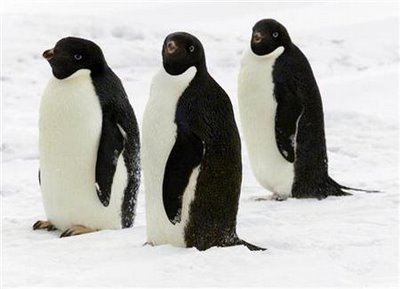Pesticide DDT shows up in Antarctic penguins

REUTERS/Mark Baker
Three Adellie penguins wait on the edge of the ice as they prepare to swim for food at Cape Evans in Antarctica February 8, 2002.
By Deborah Zabarenko
Reuters
WASHINGTON - The pesticide DDT, banned decades ago in much of the world, still shows up in penguins in Antarctica, probably due to the chemical's accumulation in melting glaciers, a sea bird expert said on Friday.
Adelie penguins, known for their waddling gait and a habit of nesting on stones, have long shown evidence of DDT in their fatty tissues, although not in enough concentration to hurt the birds, according to Heidi Geisz of the Virginia Institute of Marine Science.
But researchers were surprised to see that the level of the pesticide in Adelies' fat had not declined, even after DDT was banned for exterior use in the 1970s in the United States and elsewhere.
First noted in 1964, while the chemical was still widely used, the amount of DDT found in Adelie penguins rose in the 1970s and has stayed stable since then, Geisz said in a telephone interview.
In findings published in the journal Environmental Science & Technology, Geisz and her colleagues noted that persistent organic pollutants like DDT accumulate and become concentrated in the Antarctic ecosystem.
"DDT, along with a lot of other of these organic contaminants, actually travel through the atmosphere ... toward the polar regions by a process of evaporation and then condensation in cooler climates," Geisz said, explaining this is how the pesticide got deposited in Antarctic glaciers.
DDT declined dramatically in Arctic wildlife over the last decade, while the amount of the chemical in Antarctic Adelies stayed stable, the study said.
DDT was easily detectable in glacier melt water, Geisz said.
FOOD CHAIN
Adelies feed off tiny creatures called krill that live in melted glacier water, and DDT is transmitted up the food chain directly to the penguins.
There is not enough of the chemical to harm the birds, but it is measurable in samples of penguin corpses and their abandoned eggs, Geisz said.
Some kinds of birds that ingest DDT, especially birds of prey like the American bald eagle, produce eggs with extremely thin shells which are easily crushed by adult birds. Geisz said this has not been demonstrated to be the case with sea birds.
A more pressing issue for the Adelie penguins that breed on the Antarctic Peninsula is encroaching climate change, she said. The peninsula, which stretches north toward South America, has been warming much faster than the rest of the continent.
Warming on the peninsula means "we see more snow and more moisture and these (Adelie) eggs end up getting soaked and frozen," Geisz said. "It allows opportunities for people like me to study the eggs, but it's not necessarily ideal for the penguins."
Originally developed as a powerful multi-species pesticide, DDT was used in World War Two to clear South Pacific islands of malaria-causing insects for U.S. troops and in Europe as a de-lousing powder. The United States banned the chemical in 1972. The World Health Organization approved it in 2006 for use indoors to fight malaria.
 RSS
RSS

